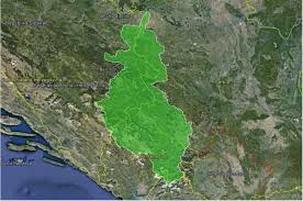Assessing the Water-Land-Energy-Food Nexus in trans-boundary river basins
Status: ongoing
Partner: UNECE
Partner: UNECE

Typically water management schemes and ecosystems preservation plans differ from one riparian country to another as well as between scales. Bilateral or multilateral agreements on water management are becoming urgent as pressure on natural resources increases. Often a lack of integration between sectors and country policies causes significant efficiency losses. Considering the water, energy, land-use and ecosystems nexus in transboundary basins aims at identifying these linkages and understanding how best to integrate them in future planning, to improve the efficiency of resources use while preserving the ecosystems and their services.
The Transboundary Diagnostic Analysis (TDΑ) is a specific framework developed for integrated water management of transboundary river basins and aquifers. This is a regional technical assessment, which identifies and quantifies water-related environmental issues. Further, UNECE’s Water Convention on the Protection and Use of Transboundary Watercourses and International Lakes is intended to strengthen national measures for the protection and ecologically sound management of transboundary surface waters and groundwater. The nexus methodology for transboundary basins was developed and consolidated at KTH-dESA, specifically for shared water bodies under the Water Convention to assess a representative set of settings in the pan-European region, Africa and Asia.
In this project, the UNECE methodology for transboundary Nexus assessments is applied to better understand the interactions between water, food, energy and water-related ecosystems in transboundary river basins. As part of the assessment, consultative stakeholder workshops are organized to identify important Nexus issues, to reflect on trade-offs between different sectors, and to discuss opportunities for synergistic planning and decision-making in the river basin. The analysis aims at the following:
1. To better understand a) the interlinkages between water, energy and food systems in the river basin under study Niger River basin; and b) the implications of river development plans on national development, people’s livelihoods and ecosystems.
2. To promote transboundary cooperation through improved understanding of the interactions between water, energy, food/ agriculture and the environment.
3. To inform the development of national water and sectoral policies as well as the legal and institutional frameworks for river basin management. So far, KTH has been involved in work for the basins of Alazani/Ganikh, in the Caucasus region; the Sava, in South East Europe; Syr Darya, in Central Asia; and most recently in the Soča/ Isonzo river basin, shared by Slovenia and Italy. Ongoing efforts now also include the Drina River Basin, a sub-basin of the Sava River.
Click here to go back to 'other projects'.
image source: unece.org
The Transboundary Diagnostic Analysis (TDΑ) is a specific framework developed for integrated water management of transboundary river basins and aquifers. This is a regional technical assessment, which identifies and quantifies water-related environmental issues. Further, UNECE’s Water Convention on the Protection and Use of Transboundary Watercourses and International Lakes is intended to strengthen national measures for the protection and ecologically sound management of transboundary surface waters and groundwater. The nexus methodology for transboundary basins was developed and consolidated at KTH-dESA, specifically for shared water bodies under the Water Convention to assess a representative set of settings in the pan-European region, Africa and Asia.
In this project, the UNECE methodology for transboundary Nexus assessments is applied to better understand the interactions between water, food, energy and water-related ecosystems in transboundary river basins. As part of the assessment, consultative stakeholder workshops are organized to identify important Nexus issues, to reflect on trade-offs between different sectors, and to discuss opportunities for synergistic planning and decision-making in the river basin. The analysis aims at the following:
1. To better understand a) the interlinkages between water, energy and food systems in the river basin under study Niger River basin; and b) the implications of river development plans on national development, people’s livelihoods and ecosystems.
2. To promote transboundary cooperation through improved understanding of the interactions between water, energy, food/ agriculture and the environment.
3. To inform the development of national water and sectoral policies as well as the legal and institutional frameworks for river basin management. So far, KTH has been involved in work for the basins of Alazani/Ganikh, in the Caucasus region; the Sava, in South East Europe; Syr Darya, in Central Asia; and most recently in the Soča/ Isonzo river basin, shared by Slovenia and Italy. Ongoing efforts now also include the Drina River Basin, a sub-basin of the Sava River.
Click here to go back to 'other projects'.
image source: unece.org
Drina River Basine Nexus Assessment
The overall objective of this project is to foster or enhance cooperation in managing transboundary waters. KTH with other parterns are working on
identifing and characterising the pertinent nexus issues in the selected transboundary tributary(ies) of the Drina River Basine. And reviewing with the riparian countries sharing the basin their national, regional and sectoral development plans affecting the basin(s). The effects of these future development scenarios will be considered (taking into account socio-economic trends and the climate change outlook). The following intersectoral “nexus” dialogue is to be informed by an analysis and assessment (with quantification whenever possible) of the benefits from a set of selected possible solutions, leading to the discussion and prioritization of a set of policy and technical recommendations and actions which could be implemented by the riparian countries.
identifing and characterising the pertinent nexus issues in the selected transboundary tributary(ies) of the Drina River Basine. And reviewing with the riparian countries sharing the basin their national, regional and sectoral development plans affecting the basin(s). The effects of these future development scenarios will be considered (taking into account socio-economic trends and the climate change outlook). The following intersectoral “nexus” dialogue is to be informed by an analysis and assessment (with quantification whenever possible) of the benefits from a set of selected possible solutions, leading to the discussion and prioritization of a set of policy and technical recommendations and actions which could be implemented by the riparian countries.

